Kevin Maik Jablonka
Lessons from the trenches on evaluating machine-learning systems in materials science
Mar 13, 2025Abstract:Measurements are fundamental to knowledge creation in science, enabling consistent sharing of findings and serving as the foundation for scientific discovery. As machine learning systems increasingly transform scientific fields, the question of how to effectively evaluate these systems becomes crucial for ensuring reliable progress. In this review, we examine the current state and future directions of evaluation frameworks for machine learning in science. We organize the review around a broadly applicable framework for evaluating machine learning systems through the lens of statistical measurement theory, using materials science as our primary context for examples and case studies. We identify key challenges common across machine learning evaluation such as construct validity, data quality issues, metric design limitations, and benchmark maintenance problems that can lead to phantom progress when evaluation frameworks fail to capture real-world performance needs. By examining both traditional benchmarks and emerging evaluation approaches, we demonstrate how evaluation choices fundamentally shape not only our measurements but also research priorities and scientific progress. These findings reveal the critical need for transparency in evaluation design and reporting, leading us to propose evaluation cards as a structured approach to documenting measurement choices and limitations. Our work highlights the importance of developing a more diverse toolbox of evaluation techniques for machine learning in materials science, while offering insights that can inform evaluation practices in other scientific domains where similar challenges exist.
Probing the limitations of multimodal language models for chemistry and materials research
Nov 25, 2024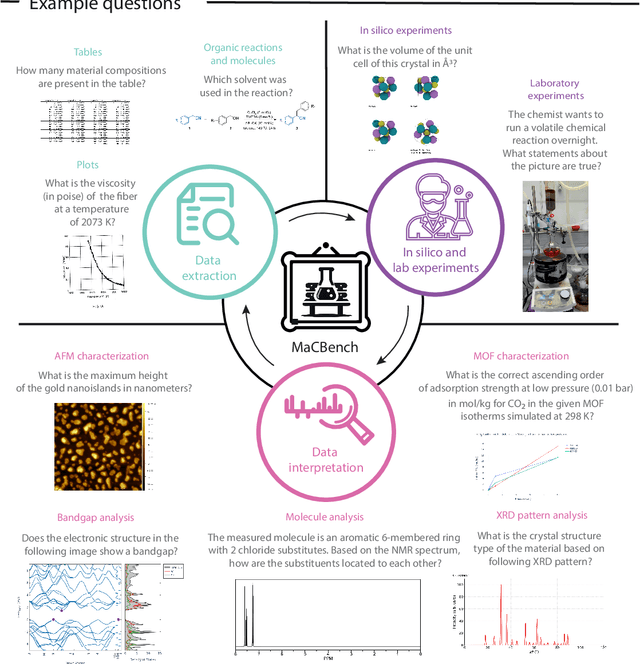
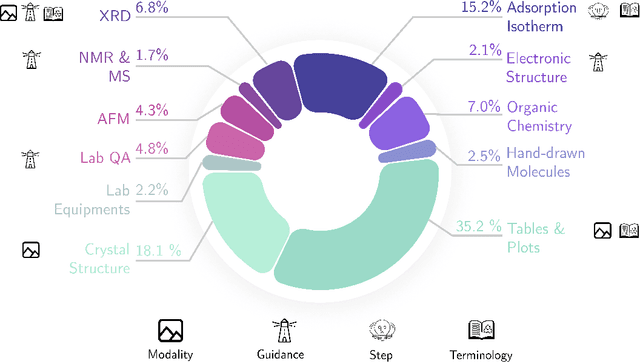
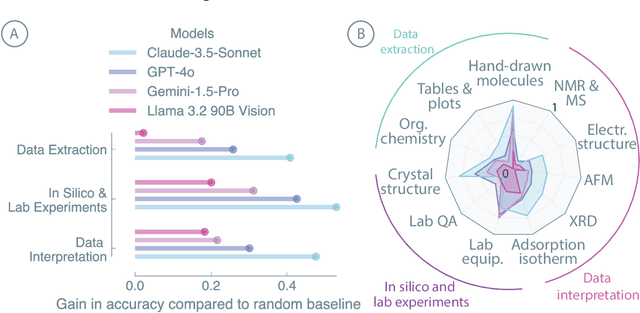
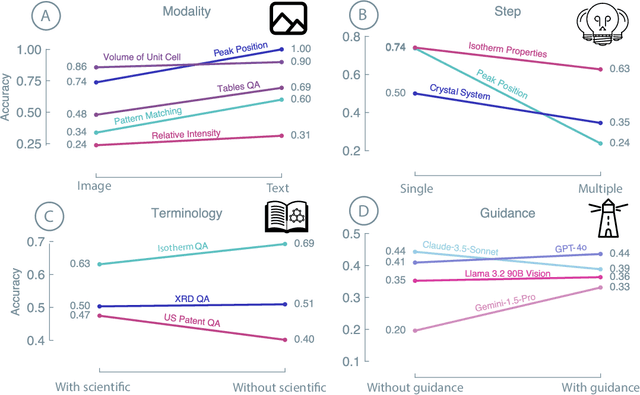
Abstract:Recent advancements in artificial intelligence have sparked interest in scientific assistants that could support researchers across the full spectrum of scientific workflows, from literature review to experimental design and data analysis. A key capability for such systems is the ability to process and reason about scientific information in both visual and textual forms - from interpreting spectroscopic data to understanding laboratory setups. Here, we introduce MaCBench, a comprehensive benchmark for evaluating how vision-language models handle real-world chemistry and materials science tasks across three core aspects: data extraction, experimental understanding, and results interpretation. Through a systematic evaluation of leading models, we find that while these systems show promising capabilities in basic perception tasks - achieving near-perfect performance in equipment identification and standardized data extraction - they exhibit fundamental limitations in spatial reasoning, cross-modal information synthesis, and multi-step logical inference. Our insights have important implications beyond chemistry and materials science, suggesting that developing reliable multimodal AI scientific assistants may require advances in curating suitable training data and approaches to training those models.
Reflections from the 2024 Large Language Model (LLM) Hackathon for Applications in Materials Science and Chemistry
Nov 20, 2024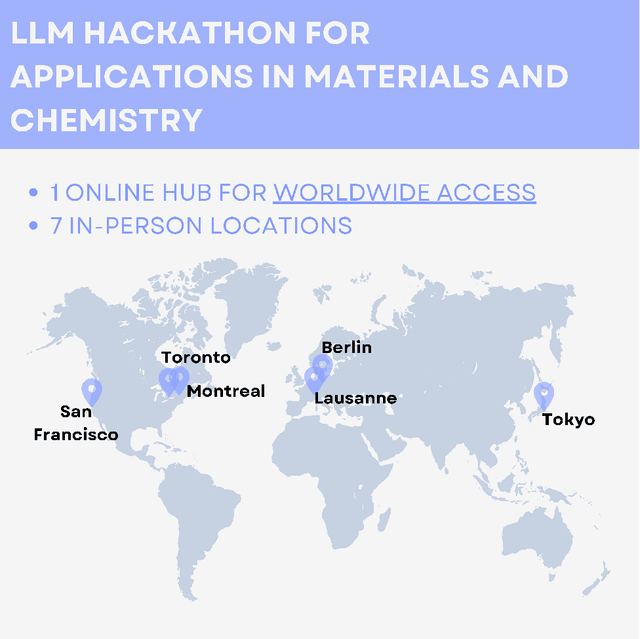
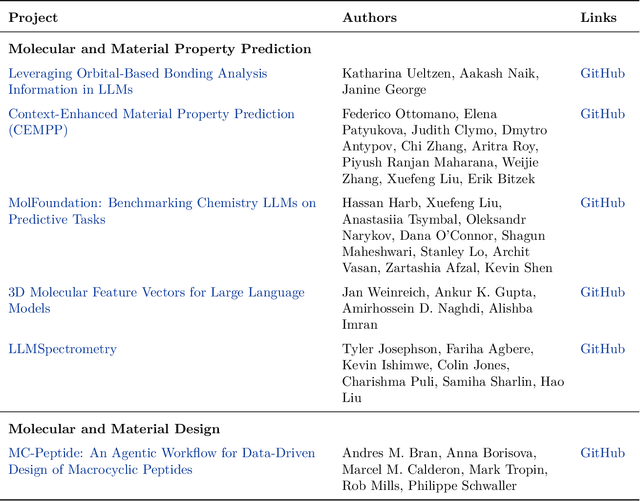
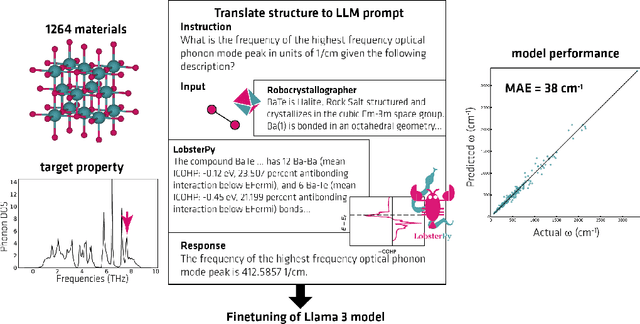

Abstract:Here, we present the outcomes from the second Large Language Model (LLM) Hackathon for Applications in Materials Science and Chemistry, which engaged participants across global hybrid locations, resulting in 34 team submissions. The submissions spanned seven key application areas and demonstrated the diverse utility of LLMs for applications in (1) molecular and material property prediction; (2) molecular and material design; (3) automation and novel interfaces; (4) scientific communication and education; (5) research data management and automation; (6) hypothesis generation and evaluation; and (7) knowledge extraction and reasoning from scientific literature. Each team submission is presented in a summary table with links to the code and as brief papers in the appendix. Beyond team results, we discuss the hackathon event and its hybrid format, which included physical hubs in Toronto, Montreal, San Francisco, Berlin, Lausanne, and Tokyo, alongside a global online hub to enable local and virtual collaboration. Overall, the event highlighted significant improvements in LLM capabilities since the previous year's hackathon, suggesting continued expansion of LLMs for applications in materials science and chemistry research. These outcomes demonstrate the dual utility of LLMs as both multipurpose models for diverse machine learning tasks and platforms for rapid prototyping custom applications in scientific research.
From Text to Insight: Large Language Models for Materials Science Data Extraction
Jul 23, 2024



Abstract:The vast majority of materials science knowledge exists in unstructured natural language, yet structured data is crucial for innovative and systematic materials design. Traditionally, the field has relied on manual curation and partial automation for data extraction for specific use cases. The advent of large language models (LLMs) represents a significant shift, potentially enabling efficient extraction of structured, actionable data from unstructured text by non-experts. While applying LLMs to materials science data extraction presents unique challenges, domain knowledge offers opportunities to guide and validate LLM outputs. This review provides a comprehensive overview of LLM-based structured data extraction in materials science, synthesizing current knowledge and outlining future directions. We address the lack of standardized guidelines and present frameworks for leveraging the synergy between LLMs and materials science expertise. This work serves as a foundational resource for researchers aiming to harness LLMs for data-driven materials research. The insights presented here could significantly enhance how researchers across disciplines access and utilize scientific information, potentially accelerating the development of novel materials for critical societal needs.
MatText: Do Language Models Need More than Text & Scale for Materials Modeling?
Jun 25, 2024



Abstract:Effectively representing materials as text has the potential to leverage the vast advancements of large language models (LLMs) for discovering new materials. While LLMs have shown remarkable success in various domains, their application to materials science remains underexplored. A fundamental challenge is the lack of understanding of how to best utilize text-based representations for materials modeling. This challenge is further compounded by the absence of a comprehensive benchmark to rigorously evaluate the capabilities and limitations of these text representations in capturing the complexity of material systems. To address this gap, we propose MatText, a suite of benchmarking tools and datasets designed to systematically evaluate the performance of language models in modeling materials. MatText encompasses nine distinct text-based representations for material systems, including several novel representations. Each representation incorporates unique inductive biases that capture relevant information and integrate prior physical knowledge about materials. Additionally, MatText provides essential tools for training and benchmarking the performance of language models in the context of materials science. These tools include standardized dataset splits for each representation, probes for evaluating sensitivity to geometric factors, and tools for seamlessly converting crystal structures into text. Using MatText, we conduct an extensive analysis of the capabilities of language models in modeling materials. Our findings reveal that current language models consistently struggle to capture the geometric information crucial for materials modeling across all representations. Instead, these models tend to leverage local information, which is emphasized in some of our novel representations. Our analysis underscores MatText's ability to reveal shortcomings of text-based methods for materials design.
Are large language models superhuman chemists?
Apr 01, 2024Abstract:Large language models (LLMs) have gained widespread interest due to their ability to process human language and perform tasks on which they have not been explicitly trained. This is relevant for the chemical sciences, which face the problem of small and diverse datasets that are frequently in the form of text. LLMs have shown promise in addressing these issues and are increasingly being harnessed to predict chemical properties, optimize reactions, and even design and conduct experiments autonomously. However, we still have only a very limited systematic understanding of the chemical reasoning capabilities of LLMs, which would be required to improve models and mitigate potential harms. Here, we introduce "ChemBench," an automated framework designed to rigorously evaluate the chemical knowledge and reasoning abilities of state-of-the-art LLMs against the expertise of human chemists. We curated more than 7,000 question-answer pairs for a wide array of subfields of the chemical sciences, evaluated leading open and closed-source LLMs, and found that the best models outperformed the best human chemists in our study on average. The models, however, struggle with some chemical reasoning tasks that are easy for human experts and provide overconfident, misleading predictions, such as about chemicals' safety profiles. These findings underscore the dual reality that, although LLMs demonstrate remarkable proficiency in chemical tasks, further research is critical to enhancing their safety and utility in chemical sciences. Our findings also indicate a need for adaptations to chemistry curricula and highlight the importance of continuing to develop evaluation frameworks to improve safe and useful LLMs.
14 Examples of How LLMs Can Transform Materials Science and Chemistry: A Reflection on a Large Language Model Hackathon
Jun 13, 2023



Abstract:Chemistry and materials science are complex. Recently, there have been great successes in addressing this complexity using data-driven or computational techniques. Yet, the necessity of input structured in very specific forms and the fact that there is an ever-growing number of tools creates usability and accessibility challenges. Coupled with the reality that much data in these disciplines is unstructured, the effectiveness of these tools is limited. Motivated by recent works that indicated that large language models (LLMs) might help address some of these issues, we organized a hackathon event on the applications of LLMs in chemistry, materials science, and beyond. This article chronicles the projects built as part of this hackathon. Participants employed LLMs for various applications, including predicting properties of molecules and materials, designing novel interfaces for tools, extracting knowledge from unstructured data, and developing new educational applications. The diverse topics and the fact that working prototypes could be generated in less than two days highlight that LLMs will profoundly impact the future of our fields. The rich collection of ideas and projects also indicates that the applications of LLMs are not limited to materials science and chemistry but offer potential benefits to a wide range of scientific disciplines.
SELFIES and the future of molecular string representations
Mar 31, 2022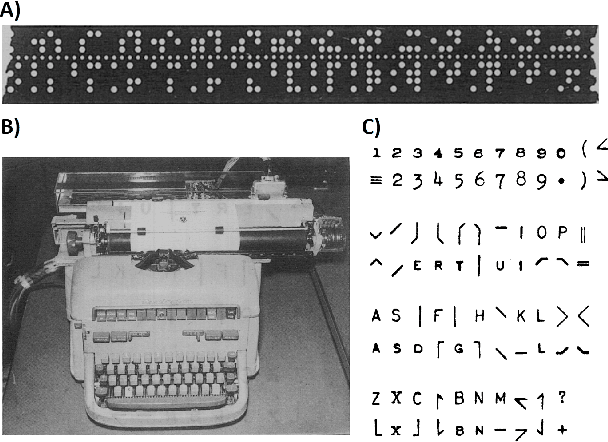
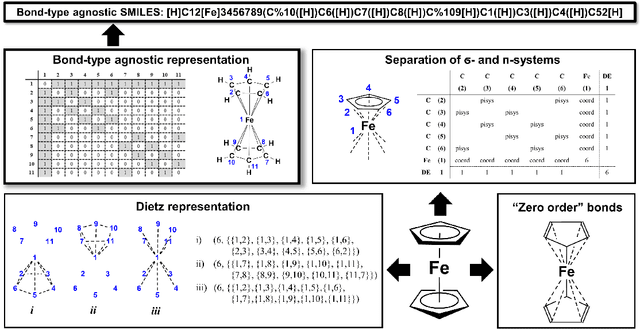

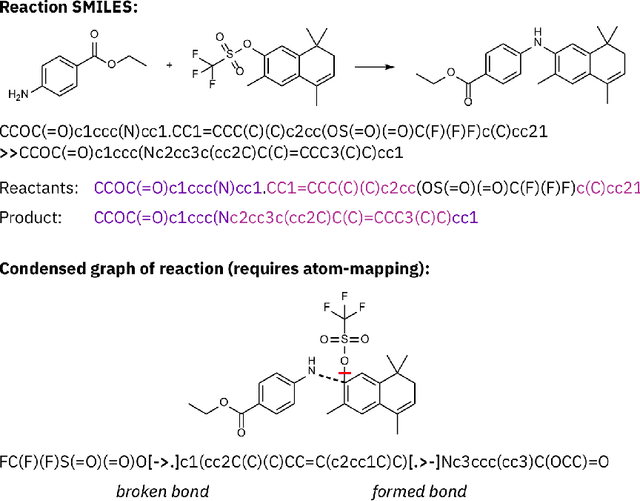
Abstract:Artificial intelligence (AI) and machine learning (ML) are expanding in popularity for broad applications to challenging tasks in chemistry and materials science. Examples include the prediction of properties, the discovery of new reaction pathways, or the design of new molecules. The machine needs to read and write fluently in a chemical language for each of these tasks. Strings are a common tool to represent molecular graphs, and the most popular molecular string representation, SMILES, has powered cheminformatics since the late 1980s. However, in the context of AI and ML in chemistry, SMILES has several shortcomings -- most pertinently, most combinations of symbols lead to invalid results with no valid chemical interpretation. To overcome this issue, a new language for molecules was introduced in 2020 that guarantees 100\% robustness: SELFIES (SELF-referencIng Embedded Strings). SELFIES has since simplified and enabled numerous new applications in chemistry. In this manuscript, we look to the future and discuss molecular string representations, along with their respective opportunities and challenges. We propose 16 concrete Future Projects for robust molecular representations. These involve the extension toward new chemical domains, exciting questions at the interface of AI and robust languages and interpretability for both humans and machines. We hope that these proposals will inspire several follow-up works exploiting the full potential of molecular string representations for the future of AI in chemistry and materials science.
A reproducibility study of "Augmenting Genetic Algorithms with Deep Neural Networks for Exploring the Chemical Space"
Feb 10, 2021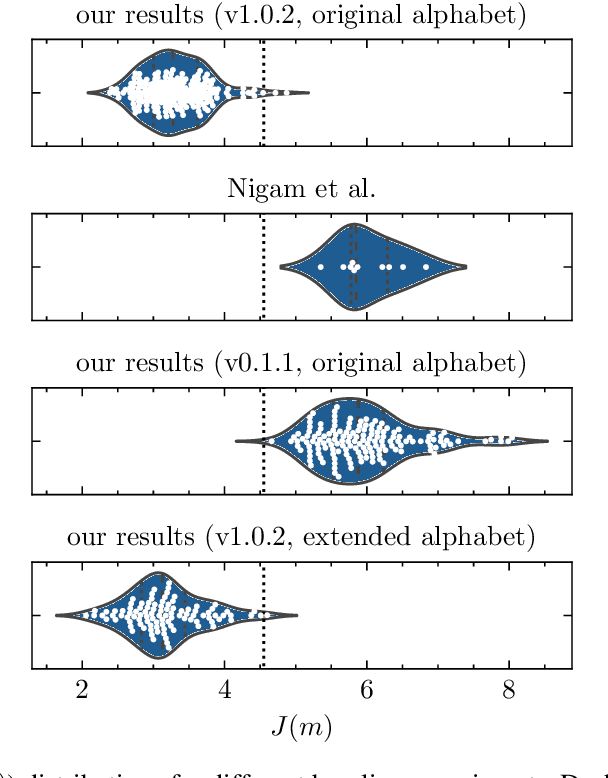

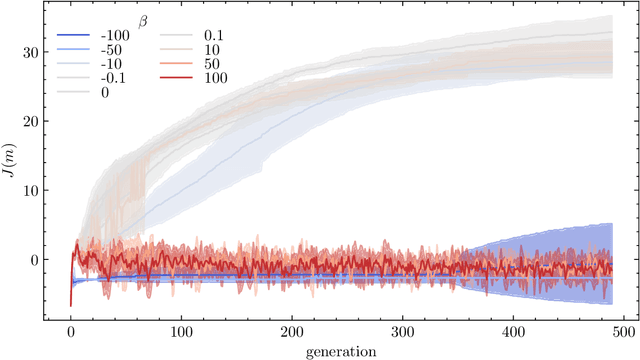
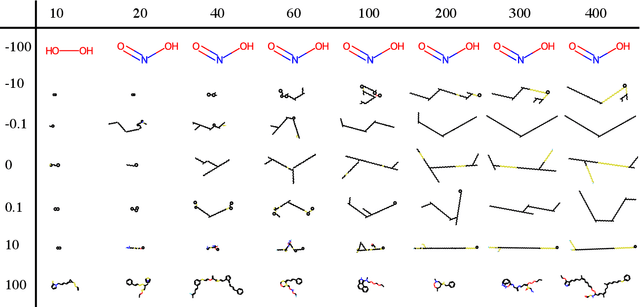
Abstract:Nigam et al. reported a genetic algorithm (GA) utilizing the SELFIES representation and also propose an adaptive, neural network-based penalty that is supposed to improve the diversity of the generated molecules. The main claims of the paper are that this GA outperforms other generative techniques (as measured by the penalized logP) and that a neural network-based adaptive penalty increases the diversity of the generated molecules. In this work, we investigated the reproducibility of their claims. Overall, we were able to reproduce comparable results using the SELFIES-based GA, but mostly by exploiting deficiencies of the (easily optimizable) fitness function (i.e., generating long, sulfur containing chains). In addition, we reproduce results showing that the discriminator can be used to bias the generation of molecules to ones that are similar to the reference set. Lastly, we attempted to quantify the evolution of the diversity, understand the influence of some hyperparameters, and propose improvements to the adaptive penalty.
Big-Data Science in Porous Materials: Materials Genomics and Machine Learning
Jan 18, 2020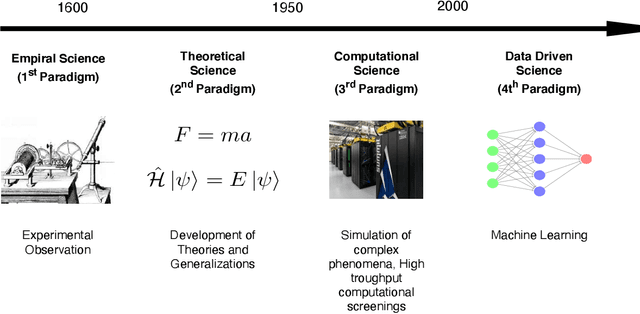
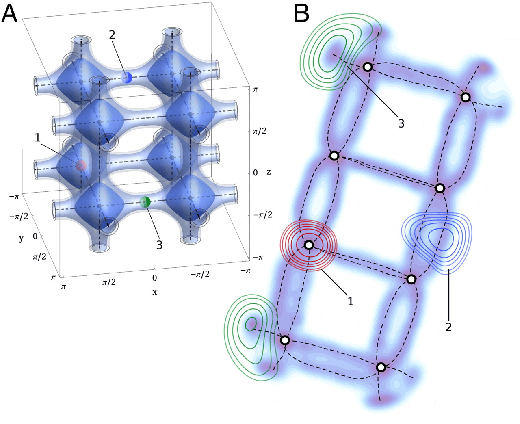
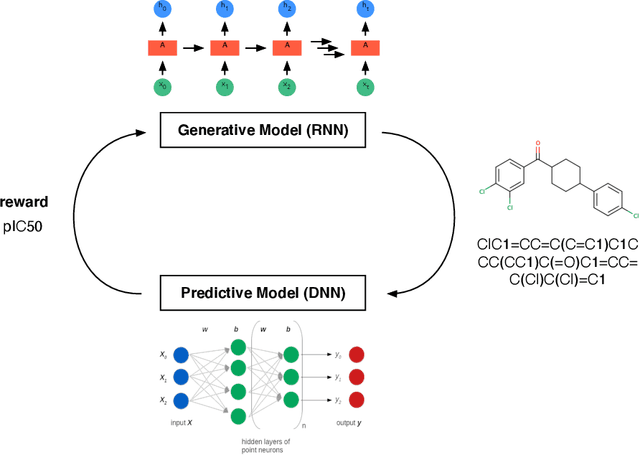
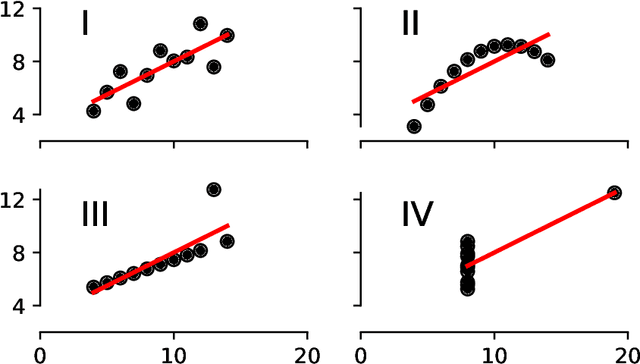
Abstract:By combining metal nodes with organic linkers we can potentially synthesize millions of possible metal organic frameworks (MOFs). At present, we have libraries of over ten thousand synthesized materials and millions of in-silico predicted materials. The fact that we have so many materials opens many exciting avenues to tailor make a material that is optimal for a given application. However, from an experimental and computational point of view we simply have too many materials to screen using brute-force techniques. In this review, we show that having so many materials allows us to use big-data methods as a powerful technique to study these materials and to discover complex correlations. The first part of the review gives an introduction to the principles of big-data science. We emphasize the importance of data collection, methods to augment small data sets, how to select appropriate training sets. An important part of this review are the different approaches that are used to represent these materials in feature space. The review also includes a general overview of the different ML techniques, but as most applications in porous materials use supervised ML our review is focused on the different approaches for supervised ML. In particular, we review the different method to optimize the ML process and how to quantify the performance of the different methods. In the second part, we review how the different approaches of ML have been applied to porous materials. In particular, we discuss applications in the field of gas storage and separation, the stability of these materials, their electronic properties, and their synthesis. The range of topics illustrates the large variety of topics that can be studied with big-data science. Given the increasing interest of the scientific community in ML, we expect this list to rapidly expand in the coming years.
 Add to Chrome
Add to Chrome Add to Firefox
Add to Firefox Add to Edge
Add to Edge